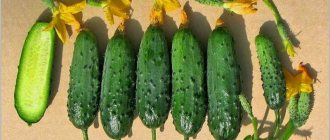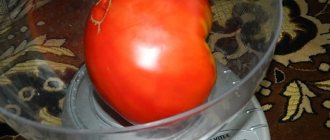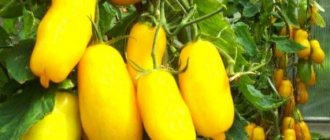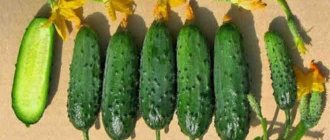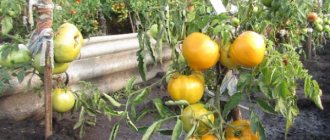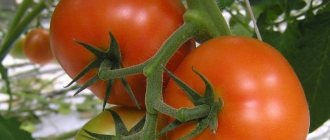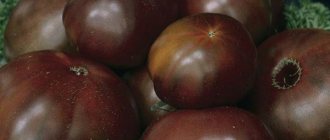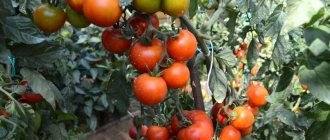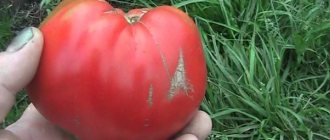» Vegetable growing » Tomatoes » Growing tomatoes Gift for a woman
0
744
Article rating
Pink tomatoes have long been a serious competitor to red varieties. A new hybrid tomato, a gift for a woman, can be found in almost every summer cottage. It attracts attention not only with its excellent taste and presentation, but also with its resistance to many diseases and pests, which simplifies gardening work for vegetable growers.
- Growing seedlings
- Transplanting seedlings
- Features of care
- Disease and pest control
- Reviews from gardeners
Growing tomatoes Gift for a woman
Characteristics and description
The F1 hybrid is the development of Russian breeders. The culture is perfectly adapted to any climatic conditions and takes root equally well both in open beds and in protected structures.
Distinctive features
Determinate bush with a strong stem and moderate foliage, up to 70 cm in height. The leaves are medium sized, dark green. Each cluster bears 4–5 fruits. Ovaries are formed in any weather conditions. The tomato tolerates hot and dry weather well. The ripening period is mid-early, the first fruits are harvested 105-110 days after emergence.
Productivity and disease resistance are high. 5–7 kg of fruits are collected from one seedling. With proper care and timely prevention, the crop is not afraid of either viral or fungal diseases, since the creators have built strong immunity into the genes of the hybrid.
The plants do not need pinching, but they cannot do without a garter. Fruitful branches strewn with ripe fruits will not withstand their weight without additional support.
Fruit characteristics
The photo shows tomatoes Gift for a woman.
The shape of ripe vegetables is round, weight 230–250 g, color deep pink.
The taste is excellent, the pulp is juicy with a small amount of seeds. The peel is dense and durable to withstand long-term transportation.
Ripe tomatoes retain their presentation for 1.5 months. The purpose in cooking is universal. Ripe vegetables are great for fresh consumption and for winter preparations. But it won’t be possible to preserve the whole thing due to its large size.
Tomatoes are used for baby food and processed into tomato products.
Features of cultivation
Tomatoes of this variety are grown by seedlings. The seeds are pre-sown and germinated at home, after which they are transplanted into open ground. Before transplanting, seedlings need to be properly cared for.
Growing seedlings
For seedlings you need to prepare a container:
- box for general sowing;
- separate small pots or glasses for sowing separately.
Before sowing, the seeds are disinfected. To do this, they need to be filled with a 1% solution of potassium permanganate and left for half an hour. Floating grains can be removed. Suitable seeds are washed with warm water and dried. While the seeds are drying, prepare the substrate. Combine soil and humus, mix. Additionally, it can be calcined in the oven for 30 minutes at a temperature of +90°C (this disinfects the soil). Pour the finished substrate into containers.
Place the seeds in the soil at the rate of 2 seeds per 1 cm². In separate glasses, place 2 grains at a distance of 1 cm from each other. Cover the seeds with a 0.5 cm layer of soil and lightly spray with water from a spray bottle. Cover the containers with cellophane film and place in a dark place with a temperature of +23...+25°C. When the first shoots appear, move the boxes with seedlings into the light.
Now the seedlings need the right conditions:
- temperature at +20…+25°С;
- bright diffused light;
- watering as the substrate dries;
- feeding with complex mineral products.
We recommend reading about what diseases can affect tomato seedlings.
When the seedlings have 2-3 leaves, they are picked. From a common box, seedlings need to be transplanted into separate pots. Seedlings in separate glasses are transplanted into containers of larger diameter. Before transplanting, care for seedlings is the same.
Preparing the site for planting
For better rooting of bushes, vegetable growers pre-treat the planting site.
The processing process is as follows:
- Loosen the soil.
- Add fertilizer in the form of humus.
- Mix the humus with the soil using a rake.
Technology of planting seedlings
Seedlings are planted using the following technology:
- Water the seedlings in pots 2-3 hours before planting.
- Dig holes. The optimal distance between beds is 0.6 m, between planting holes – 0.4 m.
- Before planting, pour 1 tbsp into each hole. l. superphosphate or crushed charcoal.
- Remove the seedlings from the pots without removing the earthen ball.
- Place the seedlings into the holes.
- Fill the planting holes with soil.
- Water the soil at the base of the bushes.
Important! Plant seedlings in the late afternoon, when the sun is no longer too active
How to grow seedlings
Seeds are sown 2 months before planting in the ground. The level of germination depends on proper preparation of seed material.
Seed preparation
Since this is not a variety, but a hybrid, you won’t be able to collect the seeds yourself—you’ll have to buy them. Viable specimens are checked by immersion in saline solution for 10 minutes. Those grains that float to the surface are empty inside, which means they are not suitable for planting. The remaining grains are disinfected in a weak solution of potassium permanganate for 20–25 minutes.
Disinfection of seed material is necessary for healthy seedling growth, but many seed producers carry out this procedure in advance. After disinfection, the seeds are washed with running water and dried.
Container and soil
For planting, a common wooden box or individual containers, for example, plastic and peat cups, are suitable. Planting containers are treated with a dark solution of potassium permanganate. Drainage holes at the bottom of each container serve to drain excess moisture. The accumulation of excess moisture can provoke rotting of young roots and the development of fungal diseases.
The soil is prepared from a mixture of garden soil and humus. To make the soil lighter, washed river sand is added. The resulting mixture is steamed in the oven at a temperature of 60°C for 10 minutes or poured with a hot solution of manganese. After wintering, many pathogenic microorganisms remain in the soil that can cause serious damage to plantings. To destroy them, the soil is disinfected.
Sowing
Seeds are sown in the first ten days of March. They are buried 1.5 cm, sprinkled with soil on top, watered with slightly warm, settled water using a spray bottle and covered with film. The film is needed to create a greenhouse effect; with this technique, seedlings appear earlier. The seeded containers are left in a dark and warm room at a temperature of 25°C.
Reference! When buried shallowly, the sprouts germinate along with the seed coat, which slows down their further growth.
Seedling care
As soon as the shoots appear, the film is removed and the containers are moved to the windowsill. During this period, seedlings need 14 hours of daylight. If there is a lack of natural light, care should be taken to install fluorescent lamps.
Reference! With a lack of light, the seedlings will begin to stretch and weaken.
Watering is carried out only with warm, settled water in small quantities. Water as the top soil layer dries out using a shallow watering can. After watering, the soil is loosened for better access of oxygen to the young roots.
Picking is carried out when 2 true leaves appear. The seedlings are planted in separate containers with a diameter of at least 15 cm. If the seedlings are left in a common container, then the distance between them is increased to 15 cm. The picking procedure involves removing the main root by one third. After this, the lateral roots begin to grow intensively.
Reference! When growing seedlings in peat cups, picking is not required.
After picking, the seedlings are fed with complex fertilizer. This first feeding is very important for the full development of young plants.
Hardening is carried out 2 weeks before transplantation. To do this, the seedlings are taken outside in the daytime for 1 hour. Gradually, the time spent outdoors is increased to 10 hours. The daytime temperature during hardening should not be less than 16°C.
Tomato cultivation
The gift for a woman belongs to the mid-early varieties. 101 days must pass from full germination to the first harvest. Depending on the climatic conditions and the tomato variety, it is necessary to decide on the methods and growing conditions.
Direct sowing of seeds in the ground is carried out only in the southern regions and, as a rule, in large-scale commercial production.
In temperate zones, since the 18th century, exclusively seedling cultivation has been used. Under the same conditions, the use of shelters (greenhouses, greenhouses) allows you to increase the yield of tomatoes by 2-3 times, depending on the variety. But at the same time, this significantly increases costs and makes the final product more expensive.
The authors of the hybrid identified cultivation in film greenhouses as the main method for it. For this case, further calculations are made.
Schedule of main events
For its construction in any region, the reference date is the time of planting seedlings in the ground. Seedlings take root when the soil temperature reaches 12 0 C at a depth of 25 cm (spade bayonet). In the middle zone in greenhouses this happens in the second ten days of May. For open ground, this date falls at the end of May - beginning of June, when the threat of night frosts has passed.
The time from the start of working with seeds to full germination is about 10 days.
As a result, we get a graph for the greenhouse growing method:
- laying seeds for germination - March 5;
- sowing seeds for seedlings - March 10;
- expected shoots – March 15;
- planting seedlings in closed ground - May 15;
- first harvest - end of June.
If tomatoes are planned to be grown in open ground, then all dates are shifted two weeks later. You can use not stationary greenhouses, but small temporary shelters made of frames and film.
Germination of seeds
Gift for a woman F1 is a first generation hybrid. It is not grown from its own seeds. Purchased branded seeds have already undergone pre-sowing treatment, so they can be immediately used for germination. This procedure is primarily a germination test. It also allows you to select the strongest and most viable shoots and stimulate their development.
The seeds are laid out on a piece of natural fabric moistened and folded in several layers. All this is done in a small food container, which is tightly closed with a lid. Seeds should not be in water - this can lead to their rotting. Seeds are germinated for 4-5 days at a temperature of 26-30 degrees.
The process is completed when the white sprouts and seeds are compared in size.
Sowing seeds for seedlings
This event is preceded by the preparation of the substrate. For sowing, you can use any purchased soil. If you use your own garden soil, then it must be disinfected by spilling a rich pink solution of potassium permanganate. This is the simplest and most reliable method of disinfection. The color of the solution characterizes its concentration (unlike hydrogen peroxide). To allow the soil to dry before using it, this must be done in advance.
The last procedure is filling the soil with a complex of mineral fertilizers with a full composition of NPK (nitrogen, phosphorus, potassium). The concentration of fat is a tablespoon per bucket of substrate.
Sowing of seeds is done immediately in separate cups or cassettes. This allows you to avoid painful picking of sprouts in the future. The depth of seed placement should not exceed 1 cm.
Growing seedlings
It is advisable to keep the crops in a warm place (27-29 0 C) until they emerge (5-7 days). After germination, they are exposed to light, usually on a windowsill. Watering the seedlings is carried out when the top layer of soil dries. Excess moisture can lead to root rot.
The shoots also need to be turned away from the light to avoid their bending.
The seedlings will turn out stronger if, during the process of growing them, they are transferred to larger containers with the stems buried. In this case, tomatoes, like all nightshades, begin to grow new roots.
The technique of deepening the stem is repeated when planting seedlings in the ground. To prevent the roots from ending up too deep, the seedlings can be buried at an angle (lying down).
Planting
Determinate bushes of medium height are planted at a density of 5 plants per square meter. meter. Depending on the format of the beds, you can use patterns of 45x45, 50x40 or 55x35 cm. Before placing the seedling in it, pour a teaspoon of full composition of fertilizer into the planting hole, mix it with the ground and drive a support peg.
Bush care
It is no different from the usual and comes down to weeding, regular watering, loosening the top layer of soil and mulching it. It is not necessary to cut off the shoots, but a garter is necessary to avoid branches breaking off under the weight of the fruit.
How to grow tomatoes
The soil for the beds is prepared in advance, 2 weeks in advance. The soil is dug up and wood ash is added. The holes are made no deeper than 20 cm and filled with warm water.
Landing
Planting pattern: 50 cm - distance between seedlings, 55 cm - row spacing. Transplant into prepared holes in the evening or on a cloudy day when the sun does not shine at full strength. The seedlings are installed vertically and buried down to the first leaves. After transplantation, the holes are compacted and watered with warm water.
Further care of the tomato Gift for a woman
Proper care of a tomato consists of moderate watering and timely application of fertilizing.
Regular watering is established as the seedlings get used to the new conditions. Water 2 times a week in normal weather. On dry or rainy days, watering is carried out as needed. Water only with settled water, at the roots of the plants.
After watering, the soil is loosened and weeds are removed. Weeds not only take nutrients from the soil that are necessary for the full growth of seedlings, but also serve as a good shelter for many pests. Therefore, the proximity of tomatoes to them is undesirable.
To prevent the beds from drying out and remaining moist longer, they are mulched with peat or straw. In addition, mulching protects the beds from ground pests.
Tomato crops are fed at least 3 times during the entire growing season: during flowering, during the formation of ovaries and at the time of fruiting. Feeding is a full complex of minerals or organic matter.
During the flowering period, they are fed mainly with phosphorus substances with the addition of boric acid. And at the time of fruiting, potassium substances are added for faster fruit filling. From organic matter, use mullein infusion or chicken manure in a ratio of 1:10.
Features of care and possible difficulties
The hybrid does not require pinching, which makes caring for it much easier. There are few lateral shoots; they not only do not take away nutrients from the plant, but also do not interfere with receiving the required amount of light. But it is advisable to remove the lower leaves before the first fruitful branch, since with constant contact with wet beds they can rot and provoke an outbreak of fungal infections.
Despite their small growth, the bushes are tied to a reliable support, otherwise the stem will not withstand the weight of the fruit-bearing branches. When transplanting, a wooden or metal support is installed next to each seedling. The stem is fixed immediately after planting in the ground, and the fruitful branches are tied up as they develop.
Diseases and pests
The hybrid genes contain high resistance to diseases such as late blight, tobacco mosaic and blossom end rot. But for prevention, experienced gardeners treat seedlings after planting in the ground with fungicidal agents. This is quite enough to protect the bushes from infections throughout the season.
To prevent pests from entering tomato beds, strongly smelling herbs are planted or the plants are sprayed with nettle infusions.
Treating the stem with a soap solution will protect against aphids, and installing pheromone traps next to the tomatoes will protect against flying whiteflies.
A thorough inspection of each seedling will help to prevent the occurrence of disease and pest invasion in time.
This is an integral preventive measure that no gardener should forget about.
Disease and pest control
If improperly cared for, tomatoes Gift for a Woman can be exposed to various threats.
Insufficient ventilation of greenhouses leads to the appearance of gray rot.
Aphids, whiteflies, slugs, rusty and spider mites, wireworms, mole crickets are pests that must be combated with insecticides or homemade plant-based solutions (decoctions of celandine, chamomile or onion peels). So, you can get rid of aphids using ordinary soapy water.
Preventative measures are necessary for this variety. In this case, the plant is sprayed with substances that include copper. Timely weeding and loosening will help avoid many problems. It would not be superfluous to treat plants with a weak solution of potassium permanganate or “Fitosporin”.
It is important to immediately remove infected or damaged plants from healthy ones to avoid infection. If you do not pay attention to protecting tomatoes from these problems, yields may decrease, and in the worst case, the plant will die.
Nuances for open ground and greenhouse conditions
When planting a hybrid in a greenhouse, do not forget about constant monitoring of temperature and humidity levels. As a rule, in greenhouse conditions these two indicators exceed the norm. At elevated temperatures and humidity, favorable conditions are created for the development of pathogenic spores. To avoid this, the greenhouse is ventilated daily. In addition, a constant flow of fresh air has a beneficial effect on the growth and development of plants.
Despite its resistance to drought, it is recommended to water the hybrid regularly. A long absence of moisture negatively affects the yield, reducing it.
The annual change of the top soil layer in the greenhouse prevents the spread of fungal infections and many pests. Pathogenic microorganisms successfully overwinter on the surface, developing in the spring and causing harm to planted crops. The new land is spilled with manganese and treated with copper sulfate.
The variety is unusual in that it can be grown at earlier stages. To do this, you will need a well-heated greenhouse. Under this condition, the seeds are sown for seedlings already in February.
Harvesting and application
Harvesting is the most awaited stage in growing any crop. The ripe fruits of the hybrid amaze with their beauty. In the sun, the color of vegetables is especially deep and warm. The fruits are not allowed to overripe; they are removed promptly in whole clusters.
Ripe tomatoes withstand any transportation well, without cracking and maintaining their presentation for a long time. The main condition is that the vegetables should not be overripe.
Tomatoes are used universally in cooking. They are ideal for preparing summer salads, slices, and various snacks. They are used to make hot and vegetable dishes.
Twisted vegetables look great combined with red and yellow varieties. The presence of such jars on the winter table looks especially festive.
When processed, delicious juices, ketchups, adjika and lecho are obtained.
Advantages and disadvantages of a hybrid
Reviews and photos indicate the numerous advantages of culture:
- possibility of landing in all regions;
- early ripening appearance;
- drought resistance;
- unpretentious care;
- strong immunity;
- high fruiting rate;
- small height;
- does not require pinching;
- excellent taste and color of fruits;
- universal purpose;
- long storage;
- long transportations.
Conditional disadvantages include the mandatory staking of plants and the impossibility of whole-fruit canning.
Farmer reviews
Many male gardeners, growing a hybrid on their plots, call the tomato nothing more than a Gift to my Wife. The culture not only fascinates with the beauty of ripe vegetables, but also pleases with its excellent taste.
Sergey, Dnepropetrovsk: “I am a summer resident with extensive experience. I have tried more than 40 varieties, and now I have been planting the hybrid Gift for a Woman for three years in a row. From each bush I remove 6-7 kg of tomatoes, large fruits with excellent taste. I feed the crop with chicken manure 2 times a season. I transport to the city by car, transportation is without problems, all vegetables are kept safe and sound.”
Maria, Volgograd: “Already in August I collect large pink tomatoes of my favorite hybrid. This is a great option for preparing juice or puree for my baby. It also tastes great in salads. But it is necessary to tie it up, otherwise the branches will break off, the fruits are too heavy. I almost always grow it in open ground.”
Features of tomato care
After planting the seedlings in a permanent place, they need to be properly cared for. Bushes need watering, fertilizing, shaping, loosening and weeding.
Watering and fertilizing rates
Tomatoes need proper watering. The optimal water temperature for irrigation is +18. +22°C. It is advisable to defend it first. You need to water the soil, not the tops, otherwise the leaves may burn.
Gift for my wife F1 - a short hybrid. One bush needs 3–5 liters of water for active growth. Usually the land is irrigated 1-2 times a week. However, the frequency of watering depends on the weather and climate. The hotter it is, the faster the soil dries out. If the ground becomes crusty or leaves hang on the bushes, vegetable growers immediately water them. For good fruiting, the bush needs fertilizing.
Gardeners who grew this variety advise fertilizing tomatoes once every 2 weeks. From organic matter, you can use mullein: 0.5 liters of the substance are diluted in 10 liters of water and stirred. You can also add 1 tbsp. l. nitrophoska. 0.5 liters of product is enough for 1 bush. It is better to use complex mineral fertilizers. However, once the bushes begin to bloom, it is best to avoid nitrogen-containing fertilizers.
Loosening the soil and weeding
Gardeners generally loosen the soil to allow air access to the rhizomes of tomatoes. Roots enriched with oxygen develop well. The quality of fruiting depends on the development of the root system. For convenience, the soil is loosened during watering. Weeds also need to be removed as they appear.

